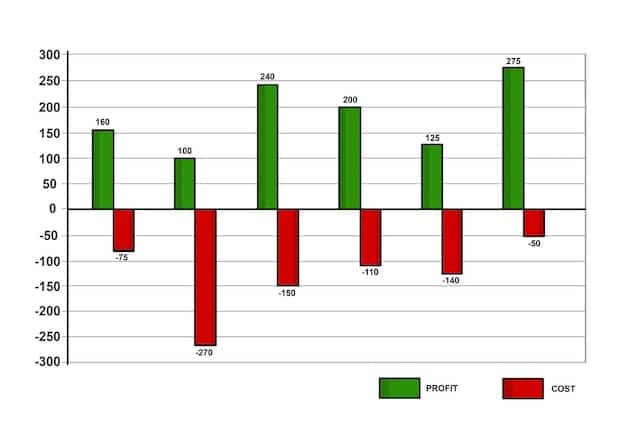Inflation Rate Soars to 4.9%: Protecting Your Purchasing Power

Inflation rate surges to 4.9%, impacting consumer purchasing power by reducing the amount of goods and services that can be bought with a fixed amount of money, necessitating strategies to mitigate financial strain.
The latest reports indicate a significant shift in the economic landscape as the inflation rate surges to 4.9%: How Will This Affect Your Purchasing Power? This increase has far-reaching implications for consumers across the United States, influencing everything from daily grocery shopping to long-term investment strategies.
Understanding the Current Inflation Rate
The recent surge in the inflation rate to 4.9% has caught the attention of economists, policymakers, and everyday consumers alike. This increase signals a potential shift in economic stability and raises questions about the factors contributing to this rise.
Understanding the causes and implications of this inflation rate is crucial for making informed financial decisions and navigating the evolving economic landscape.
What is Inflation?
Inflation refers to the rate at which the general level of prices for goods and services is rising, and subsequently, purchasing power is falling. It’s a key indicator of economic health, reflecting the balance between supply and demand in the economy.
Factors Contributing to the 4.9% Surge
Several factors contribute to the upswing in inflation. These include increased consumer demand, supply chain disruptions, and rising energy prices. Government stimulus measures and low interest rates can also play a role, injecting more money into the economy and potentially driving up prices.

Here are some of the primary drivers behind this recent surge:
- Increased Consumer Spending: As the economy recovers, consumers are spending more, driving up demand.
- Supply Chain Bottlenecks: Disruptions in the global supply chain have limited the availability of certain goods, leading to price increases.
- Energy Prices: Rising costs for oil and natural gas directly impact transportation and production costs, which are then passed on to consumers.
In summary, the 4.9% inflation rate is a multifaceted issue with underlying causes that include both demand-side and supply-side factors. Recognizing these drivers is essential to understanding the potential impacts on purchasing power and personal finances.
How Inflation Erodes Purchasing Power
When the inflation rate rises, one of the most immediate effects is the erosion of purchasing power. This means that each dollar you earn can buy fewer goods and services than it previously could. Understanding how this works is essential for managing your finances effectively.
The impact of inflation on purchasing power varies depending on income levels, spending habits, and the specific goods and services affected by price increases.
The Direct Impact on Your Wallet
As prices rise, the real value of your savings and income decreases. This can create a significant strain, especially for those on fixed incomes, such as retirees. Managing this requires a clear understanding of how inflation affects your day-to-day expenses.
Examples of Decreased Purchasing Power
Consider the following examples. If a gallon of milk cost $3 last year and now costs $3.30 due to a 10% inflation rate, your purchasing power for milk has decreased. Similarly, if the cost of your regular grocery basket increases, you’re effectively getting less for the same amount of money.

Mitigating the effects of decreased purchasing power involves proactive financial planning and strategic adjustments to spending habits. Here are some effective strategies:
- Budgeting: Track your expenses to identify areas where you can cut back.
- Investing: Consider investments that historically outpace inflation, such as stocks or real estate.
- Negotiating: Look for opportunities to negotiate better deals on bills and services.
In conclusion, the erosion of purchasing power is a significant consequence of inflation, impacting consumers across various aspects of their financial lives. By understanding how inflation affects your money and implementing strategic financial practices, you can protect your purchasing power and maintain financial stability.
Strategies to Combat Inflation’s Impact
Given the challenges posed by a rising inflation rate, it’s crucial to develop strategies to protect your finances. Implementing these strategies can help you maintain your standard of living and mitigate the negative effects of inflation on your purchasing power.
These strategies range from adjusting your investment portfolio to making smarter purchasing decisions and seeking additional income opportunities.
Investing Wisely During Inflation
One of the most effective ways to combat inflation is through strategic investing. Certain asset classes tend to perform well during inflationary periods, offering a hedge against the declining value of money.
Adjusting Spending Habits
Another critical strategy is to adjust your spending habits. By becoming more mindful of your expenses and making informed purchasing decisions, you can reduce the impact of inflation on your budget.
Here are some effective approaches to consider:
- Diversify Investments: Consider assets like real estate, commodities, and inflation-protected securities.
- Seek Higher Returns: Explore investment options with the potential for higher returns, but be aware of the associated risks.
- Shop Around: Compare prices at different stores to find the best deals.
In conclusion, combating inflation’s impact requires a proactive and multifaceted approach. By investing wisely, adjusting your spending habits and negotiating better deals, you can mitigate the negative effects of inflation on your financial well-being and preserve your purchasing power.
The Role of the Federal Reserve
The Federal Reserve (also known as The Fed) plays a critical role in managing inflation and maintaining economic stability. As the central bank of the United States, the Fed has several tools at its disposal to influence the money supply and control inflationary pressures.
Understanding the Fed’s actions and their potential impact is essential for anticipating economic trends and making informed financial decisions.
How the Federal Reserve Influences Inflation
The Fed primarily uses two main tools to manage inflation: adjusting the federal funds rate and conducting open market operations. These actions influence interest rates and the availability of credit in the economy.
Recent Actions Taken by the Federal Reserve
In response to the recent surge in the inflation rate to 4.9%, the Federal Reserve has taken several measures to try to curb rising prices. These actions include raising interest rates and reducing its balance sheet.
The Federal Reserve’s toolkit includes:
- Raising Interest Rates: Increasing the federal funds rate makes borrowing more expensive, which can slow down economic activity and reduce demand.
- Open Market Operations: Buying or selling government securities to influence the money supply and interest rates.
- Quantitative Tightening: Reducing the size of the Fed’s balance sheet by allowing bonds to mature without reinvesting, which decreases the money supply.
In short, the Federal Reserve’s actions have a significant impact on the economy and the fight against inflation. By closely monitoring the Fed’s policy decisions and understanding their potential effects, consumers and investors can better prepare for the economic changes ahead.
Impact on Different Income Groups
Inflation does not affect all income groups equally. Lower-income households often feel the pinch of rising prices more acutely than higher-income households because a larger percentage of their income is spent on necessities such as food, housing, and transportation.
This disparity in impact highlights the importance of understanding how inflation affects different segments of the population and tailoring financial strategies accordingly.
How Lower-Income Households Are Affected
Lower-income families typically have less discretionary income and fewer savings to fall back on when prices rise. This makes them particularly vulnerable to the effects of inflation, as they may struggle to afford essential goods and services.
Strategies for Lower-Income Households
To mitigate the impact of inflation, lower-income households can focus on budgeting, seeking assistance programs, and making smart purchasing decisions. Small changes in spending habits can make a significant difference in managing expenses.
Here are some tips for lower-income households:
- Maximize Savings: Even small amounts of savings can provide a cushion during inflationary periods.
- Utilize Assistance Programs: Take advantage of programs like SNAP and LIHEAP to help cover essential expenses.
- Seek Additional Income: Explore opportunities for part-time work or side hustles to supplement income.
In summary, the impact of inflation varies significantly across different income groups, with lower-income households often bearing the brunt of rising prices. By understanding these disparities and implementing targeted financial strategies, families can better navigate the challenges of inflation and maintain their financial well-being.
Future Outlook and Predictions
Looking ahead, forecasting the future direction of inflation is a complex task, influenced by a variety of economic factors and global events. While predictions are not guarantees, they can provide valuable insights for planning and decision-making.
Economists and financial experts offer diverse perspectives on the future outlook for inflation, considering factors such as monetary policy, supply chain dynamics, and geopolitical developments.
Expert Opinions on Inflation Trends
Some experts believe that the current high inflation rate is transitory and will eventually subside as supply chain issues are resolved and demand moderates. Others warn that inflation could persist for longer, driven by factors such as wage growth and government spending.
Potential Scenarios and Their Implications
Several potential scenarios could play out in the coming months and years, each with its own implications for consumers and the economy. These include:
- Continued High Inflation: If inflation remains elevated, consumers may need to further adjust their spending habits and investment strategies.
- Moderate Inflation: A gradual decline in inflation would provide some relief to consumers but still require careful financial management.
- Recession: A sharp economic downturn could lead to deflation, but also job losses and financial instability.
In conclusion, while the future of inflation remains uncertain, staying informed about economic trends and expert opinions can help you prepare for various scenarios. By adopting a proactive approach to financial planning and making informed decisions, you can navigate the challenges of inflation and protect your financial well-being, regardless of what the future holds.
| Key Point | Brief Description |
|---|---|
| 💰 Inflation Impact | Reduces purchasing power, making goods more expensive. |
| 📈 Fed’s Role | Manages inflation by adjusting interest rates. |
| 🛒 Spending Strategies | Budgeting and smart shopping can help mitigate effects. |
| 💼 Investment Options | Consider assets like real estate or inflation-protected securities. |
Frequently Asked Questions
▼
The current inflation rate has surged to 4.9%, reflecting a significant increase in the general level of prices for goods and services in the economy.
▼
Inflation reduces your purchasing power by decreasing the quantity of goods and services you can buy with a fixed amount of money. Rising prices erode the value of each dollar.
▼
You can protect yourself by budgeting, investing in assets that tend to outpace inflation, negotiating bills, and seeking additional income opportunities to offset rising prices.
▼
The Federal Reserve manages inflation by adjusting interest rates and conducting open market operations, influencing the money supply and credit availability in the economy.
▼
Inflation disproportionately affects lower-income groups, who spend a larger percentage of their income on necessities. Higher-income groups have more discretionary spending and savings to buffer against rising prices.
Conclusion
In conclusion, the surge in the inflation rate surges to 4.9%: How Will This Affect Your Purchasing Power? has far-reaching implications for consumers, requiring proactive financial planning and strategic adjustments to spending and investment habits to mitigate its adverse effects. By understanding the drivers of inflation, the role of the Federal Reserve, and the impact on different income groups, individuals can make informed decisions to protect their financial well-being in an evolving economic landscape.





